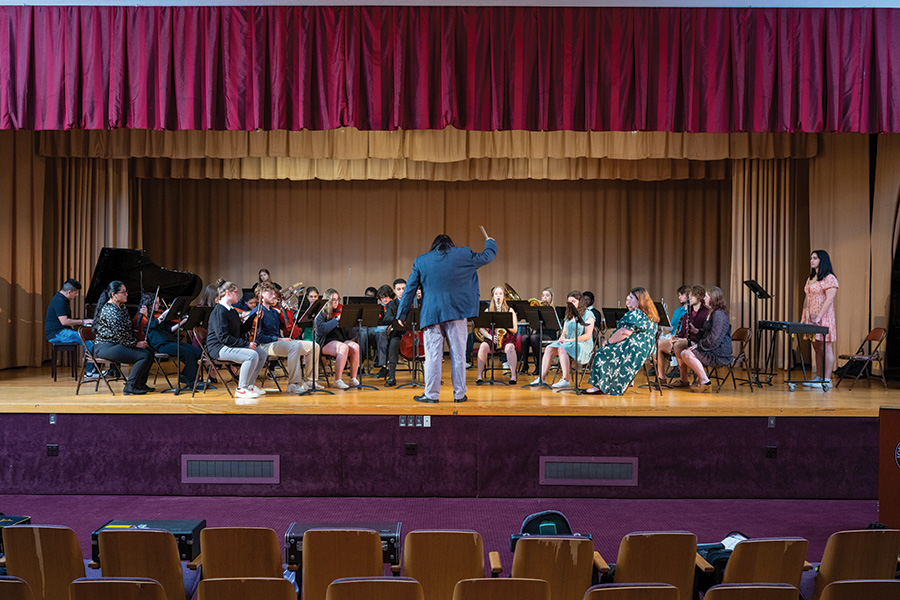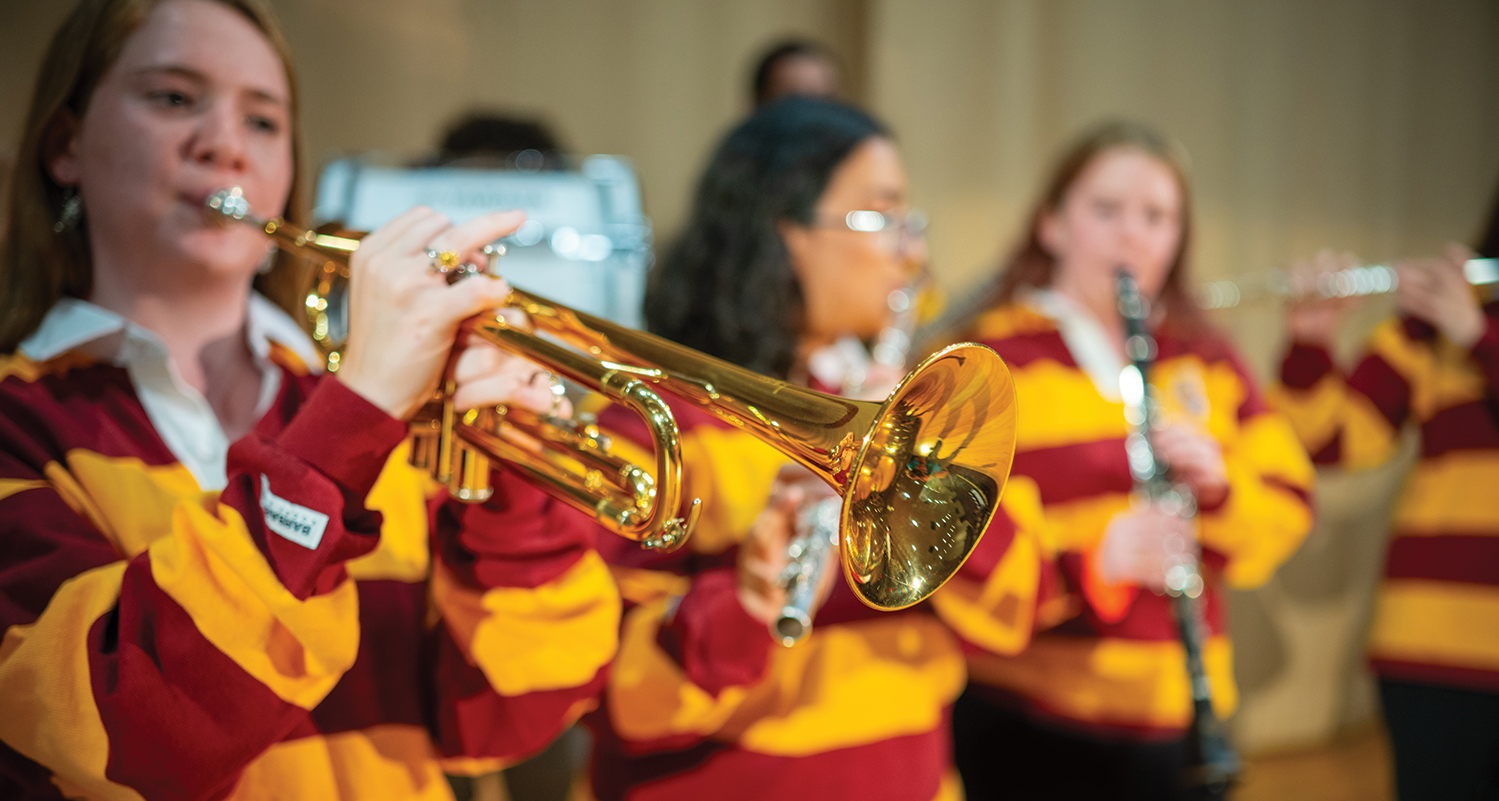Developing the Voices of Iona’s Musical Ensembles
By Adam P. Rosado, Ph.D., Assistant Professor of Music
Every person has a voice. When you meet someone, your voice is one of the indelible things that imprints you in their mind. The sound of your voice and what you say with it literally and figuratively tell the world who you are. But it’s not just individuals who have voices—groups and institutions do, too, especially when those institutions have bands and choirs.
Since I took over the directorship of the Iona University Instrumental Ensemble in 2020 and the Pep Band in 2021, I’ve been working with my colleagues and students to try to answer the question: “What do we want our groups’ voices to sound like?”
While these two ensembles are different, I always think of how we craft their voices in tandem. This is partially because a lot of students perform in both groups, but also because they share the primary audience of those in our campus community. Because of this, our voices need to complement each other, as well as those of our many performing friends on campus.
In addition to the groups I conduct, the pipe band, directed by Liam Geer ’21; the Vocal Ensemble, directed by Prof. Patricia Smith; the Iona Singers and the Music Ministry, both directed by Dana Celestino; and the Iona Players also allow Iona’s musically talented students to exercise their artistry and make the University a more vibrant place.
One of the ways both Pep Band and Instrumental Ensemble have shaped our voices is through the pieces we choose to program. A lot of thought goes into each selection and it ends with a truly unique group of songs—I don’t know anywhere else you can go to hear a set quite like ours.

The first thing that is imperative is considering the students in the band: what do they like, what will they sound good on, and what will make them better? The Music Program’s 2022 winter concert was entitled FREEDOM. When I selected “The Story of Tonight” from Hamilton by Lin Manuel Miranda, I didn’t think of a saxophone playing the introduction, I thought of our saxophonist, Alexis Armstrong ’25 playing it, and how she would sound playing it in Murphy Auditorium.
When I chose to program Márquez’s Danzón No.2 for this year’s winter concert, it was because our string section would be excited to play it, which is the same reason the Pep Band plays “Vehicle” by Ides of March year in and year out. When the Pep Band started playing Jay-Z’s “Heart of the City (Ain’t No Love)” last year, it was because I knew our winds and brass would find the flute part on the original recording challenging, and it is a challenge they rose to meet beautifully in our arena, on the Boardwalk of Atlantic City, and on our trip to March Madness.
Iona’s campuses are more than classrooms and quads; they’re a community of people, and those people are the first ones we think about when choosing any piece to perform.
The second factor that plays heavily into our programming is education. Iona is a university, and the pieces our groups play tie into all the other things our students learn. Last spring, I taught a brand-new class, Music of New York, for the first time. At our Spring Concert, Instrumental Ensemble performed a set that was a love letter to the city’s musical history that dovetailed with the themes in my other course. Our string section performed an excerpt of the “American Quartet” by Antonín Dvořák, the most famous composer to call NYC home in the 19th century. Later, the whole ensemble played “Mi Gente,” made famous by Hector Lavoe and La Fania All Stars, which was a piece we studied intently during lectures. The group also performed with saxophonist Dr. John Petrucelli, a 20-year veteran of the New York jazz scene, whose experience was profoundly impactful for the group.
For each of the last two years, I’ve also brought my Music Appreciation class to basketball games to hear the Pep Band. The songs get the crowd moving, and classics like “Rock and Roll Pt. II (The Hey Song)” by Gary Glitter, “Pepas” by Farruko, and “Danza Kuduro” by Don Omar ft. Lucenzo are great for teaching not only the basic fundamentals of music, but also how the brain processes music and stirs up our emotions.
Even though music is what we do, we think about non-musical education in our programming as well. The Pep Band plays Ariana Grande’s “Bang Bang” to support the Dance Team, who had already learned a choreographed routine to that song. Instrumental Ensemble performed alongside the Vocal Ensemble for a conference hosted by the Institute for Thomas Paine Studies, where our performance featured an original spoken word setting I wrote of Paine’s The American Crisis No. 1, read by Instrumental Ensemble mellophonist (and pipe band snare drummer) Justin Taveras ’22.
The last aspect of the ensemble’s programming was inspired by our core curriculum, which serves all undergraduates at the University. The goal is to give them a global perspective, but one rooted here at home, at Iona. Music doesn’t come from nowhere; it is a product of the time and place it was created. We make music produced by New Rochelle and Bronxville, by Westchester County and New York City, by the United States, and by planet Earth. The Pep Band’s performances of “X Gon Give it to Ya” by Mount Vernon native DMX are to remind students of their roots here and the influential art created in their own backyard.
While we strive to play fun songs like “X,” we don’t shy away from more serious issues. When the Russian Army first invaded Ukraine, Vladimir Putin made many false claims about Ukrainian culture in addition to the physical attacks that marked the start of the ongoing war. Later that week, the Pep Band premiered an original arrangement of “Shum” by Go_A, the Ukranian entrants in the previous year’s Eurovision Song Contest. The piece is a 21st century take on a vesenyanka, a harvesting folksong style native to Ukraine. At our FREEDOM concert the following winter, Instrumental Ensemble played “Shum,” an anthem by Ukrainian group Kalush Orchestra, as well as “Protect the Land” by System of a Down, which the artists released to support those affected by the conflict in the disputed Artsakh/Nagorno-Karabakh region on the border of Armenia and Azerbaijan.
There is a lot that goes into defining your voice, and even more that goes into selecting what to say with it. We strive to make our voice, well, ours. The process is informed by what we want to hear, but also what we need to say with more power and clarity than our words can manage. Just like our member’s individual voices, sometimes we say things that are fun, sometimes serious things, and sometimes new things we’ve just learned, but always what we believe is deeply vital to be heard.
When a Gael’s voice speaks—even through an instrument—listen clearly; you’ll want to hear what they have to say.



Comments are closed, but trackbacks and pingbacks are open.